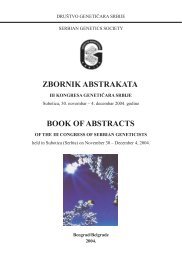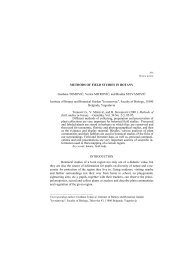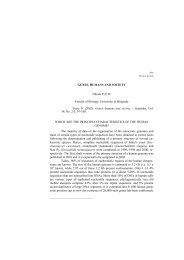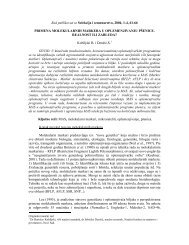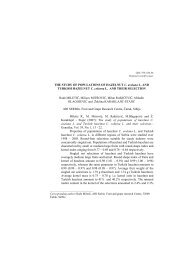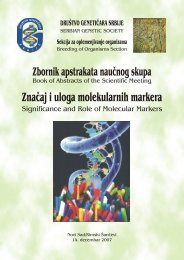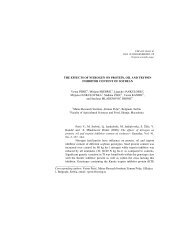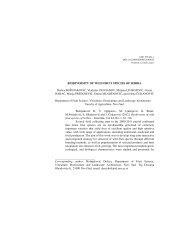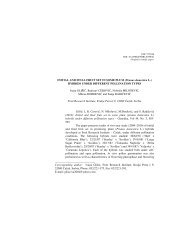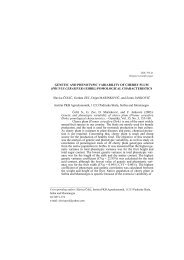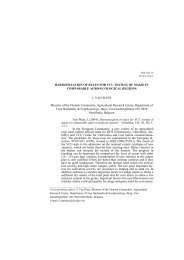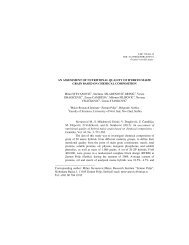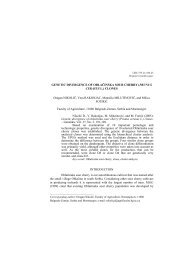Corresponding author: Kojic Lazar, Maize Research ... - doiSerbia
Corresponding author: Kojic Lazar, Maize Research ... - doiSerbia
Corresponding author: Kojic Lazar, Maize Research ... - doiSerbia
You also want an ePaper? Increase the reach of your titles
YUMPU automatically turns print PDFs into web optimized ePapers that Google loves.
UDC 575: 633.15<br />
Original scientific paper<br />
BREEDING AND GENETIC PROPERTIES OF THE MAIZE VARIETY<br />
UZBEKSKA BELA<br />
<strong>Lazar</strong> KOJIC 1 and Dillyara AJGOZINA 2<br />
1 <strong>Maize</strong> <strong>Research</strong> Institute, Zemun Polje, Belgrade, Serbia<br />
2 SPK "Budan", Almatinska 51, p. Balatay, Kazakhstan<br />
<strong>Kojic</strong> L. and Dillyara Ajgozina (2008): Breeding and genetic<br />
properties of the maize variety Uzbekska bela (Uzbekh white). - Genetika,<br />
Vol. 40, No1, 17-21.<br />
The Uzbekska bela (Uz.b.) maize variety was crossed to nine inbred lines<br />
and genetic difference between this variety and observed maize inbreeds<br />
lines was determined. The Uz.b. variety is a heterotic pair interesting for<br />
deriving maize hybrids with inbreds of BSSS and Lancaster origin, as well<br />
as, with some Yugoslav maize populations (Konjski zub, Domaci tvrdunac).<br />
The inbred lines originating from Zambia showed somewhat lower<br />
yielding and heterosis percentage in relation to other observed inbred lines<br />
in hybrid combinations with the variety Uz.b.<br />
Key words: grain yield, heterosis, heterotic pair.<br />
______________________________<br />
<strong>Corresponding</strong> <strong>author</strong>: <strong>Kojic</strong> <strong>Lazar</strong>, <strong>Maize</strong> <strong>Research</strong> Institute, Slobodana Bajica 1,<br />
11185 Belgrade-Zemun,Serbia
18 GENETIKA, Vol. 40, No. 1, 17 -21, 2008.<br />
INTRODUCTION<br />
The success of newly initiated maize breeding programmes greatly<br />
depends on evaluation, development and improvement of the initial material<br />
(HALLAUER, 1988; MORENO-GONZALES, 1988; DRINIC et al., 1992; IVANOVIC et<br />
al. 1995; DHILLON et al., 1997; KOJIC and AJGOZINA, 2000).<br />
Therefore when formulating the programme on the development of maize<br />
hybrids of high genetic yielding potential and grain quality, whose implementation<br />
began in Kazakhstan in 1993, the set goal was to evaluate the initial breeding<br />
material and depending on its breeding and genetic potential to include it into the<br />
programme of the development of new inbred lines of high combining abilities.<br />
MATERIALS AND METHODS<br />
The Uzbekska bela (Uz.b.) maize variety was used in the experiment and<br />
was crossed to nine inbred lines. Three inbred lines originated from the States (FR<br />
809 and B73 of the BSSS group and Mo17 of the Lancaster origin), two inbreds<br />
were from Yugoslavia (P3/72-22, derived from crosses of the local populations<br />
Konjski zub x Domaci tvrdunac, L 17/17, derived from the synthetic population<br />
Syn 6/9(l) Co of the Lancaster origin) and four inbred lines originated from<br />
Zambia (L7, N 3, L 9-2 and L 12-7).<br />
The hybrid combination B73 x Mo17 was used as a check in this study.<br />
The three-replicate trial was set up according to the randomized block<br />
design in the vicinity of Alma-Ata, Kazakhstan in 1995 and 1996. The obtained<br />
results were processed by the analysis of variance and the superior (Uz.b.)-parent<br />
heterosis was evaluated.<br />
Beside hybrid combinations developed by continuous self-pollination, six<br />
inbred lines were derived from Uz.b., crossed to Mo17 and then observed in trials<br />
during 2003 and 2004.<br />
RESULTS AND DISCUSSION<br />
The average grain yield of the variety Uz.b. was 8,045 kg ha -1 (Table 1). It<br />
was lower by 35.9% than the yield of B73 x Mo17. The yield obtained in hybrid<br />
combinations Uz.b. x P3/72-22, Uz.b. x F 809, Uz.b. x B73 and Uz.b. x Mo17 was<br />
at the level of the yield obtained in the hybrid B73 x Mo17 (existing differences<br />
were not statistically significant). The superior-parent heterosis evaluated in these<br />
hybrid combinations amounted to 151.2%, 148.2%, 146.5% and 146.4% in Uz.b. x<br />
P3/72-22, Uz.b. x F809, Uz.b. x B73 and Uz.b. x Mo17, respectively. Although<br />
heterosis percentage amounted to 139.2% in the hybrid combination Uz.b. x<br />
L17/17, the yield of this combination was lower by 10.7% than the yield of the<br />
hybrid B73 x Mo17.<br />
Grain yields registered in hybrid combinations among Uz.b. and inbred<br />
lines from Zambia (L7, N3, L9-2 and L12-7) were lower than the grain yield of the<br />
hybrid B73 x Mo17, while heterosis percentage varied from 120.4 to 131%.<br />
According to the stated it can be concluded that the variety Uz.b. is a heterotic pair<br />
interesting for the development of maize hybrids with inbreds of BSSS and
L.KOJIC and D.AJGOZINA: MAIZE VARIETY UZBEKSKA BELA 19<br />
Lancaster groups and some Yugoslav maize populations (Konjski zub, Domaci<br />
tvrdunac).<br />
Table 1. Grain yield (kg ha -1 ), heterosis percentage, grain moisture (%) and lodged and<br />
broken plants (%) in 1995 and 1996<br />
Table 2. Grain yields (kg ha -1 ) and grain moisture (%) at harvest in 2003 and 2004<br />
Hybrid Grain yield<br />
(kg ha -1 Heterosis Grain moisture<br />
)<br />
%<br />
(%)<br />
2003 2004 X 2003 2004 X<br />
L730/9 x Mo17 11.210* - - - 29.0 - -<br />
L372/9 x Mo17 9.913** - - - 30.7 - -<br />
L733/9 x Mo17 8.960** - - - 24.6 - -<br />
L734/9 x Mo17 10.240** - - - 23.7 - -<br />
L735/9 x Mo17 12.630 17.491 15.061 98.5 28.3 22.0 25.2<br />
L736/9 x Mo17 12.760 17.248 15.004 98.1 28.1 26.3 27.2<br />
B73 x Mo17 13.040* 17.555 15.298 100.0 28.0 23.2 25.6<br />
Two out of six inbreds (L730/9, L732/9, L733/9, L734/9, L735/9, L736/9)<br />
derived from the variety Uz.b. were crossed to Mo17 (Table 2) and had a grain<br />
yield at the level of B73 x Mo17. Since the variety Uz.b. is of subtropic origin, it is<br />
very luxuriant and has a great amount of green mass, hence inbreds derived from<br />
this variety should be adequately crossed to result in combinations favorable for<br />
silage production.<br />
Beside grain yield other traits were also studied: plant height, ear height,<br />
ear length, cob diameter. It should be stressed that Uz.b. has a high stalk (329.7-<br />
342.7 cm) and the ear highly formed on the stalk (175.3-180.3 cm), which<br />
adversely affects the plant stability (% of lodged and broken plants ranged from<br />
1.0% to14.3%, Table 1). Furthermore, tasseling occurs eight days later and silking<br />
occurs 12 days later in Uz.b. than in B73 x Mo17, which means that the growing<br />
period of Uz.b. is significantly longer than the growing period of the hybrid B73 x<br />
Mo17.
20 GENETIKA, Vol. 40, No. 1, 17 -21, 2008.<br />
CONCLUSIONS<br />
According to obtained results it can be concluded that there is a genetic<br />
difference between the variety Uz.b. and observed maize inbred lines. The variety<br />
Uz.b. is a heterotic pair interesting for the development of maize hybrids with<br />
inbreds of BSSS and Lancaster groups, as well as, with some Yugoslav maize<br />
populations (Konjski zub, Domaci tvrdunac). The inbred lines originating from<br />
Zambia showed somewhat lower yielding and heterosis percentage in relation to<br />
other observed inbred lines in hybrid combinations with the variety Uz.b.<br />
The variety Uz.b. can be used in the process of the development of new<br />
inbred lines with the strict selection of plants for certain properties (plant and ear<br />
height, plant stability) and/or of the development of synthetic populations as a<br />
source breeding material by using appropriate donors for the improvement of those<br />
properties, which are not, according to the set goal of the breeding programme,<br />
satisfactory (plant stability, ear height).<br />
REFERENCES<br />
Received November 28 th , 2007<br />
Accepted February 28 th , 2008<br />
DHILLON B.S., N.S. MALHI and V.K. SAXENA (1997): Heterosis in crops, 17-22 august, 74-75, Mexico<br />
City, Mexico.<br />
DRINIĆ, G, L. KOJIĆ, M. BABIĆ, and JELENA VANČETOVIĆ (1992): The multiple regression analysis for grain<br />
yield and four agronomically important traits of maize (Zea mays L.). Genetika, Vol. 24, No.3,<br />
Pp. 195-200.<br />
HALLAUER, A.R. (1988): Modern methods in maize breeding. <strong>Maize</strong> breeding a maize production.<br />
EUROMAIZE '88: 1-20, 06-08, October, Belgrade<br />
IVANOVIĆ, M., R. PETROVIĆ, G. DRINIĆ, V. TRIFUNOVIĆ, L. KOJIĆ, M. VUKOVIĆ, M. MIŠOVIĆ, GORDANA<br />
RADOVIĆ, D. RISTANOVIĆ, ZORICA PAJIĆ, B.V. TRIFUNOVIĆ i D. JELOVAC (1995): Pedeset godina<br />
selekcije ZP hibrida kukuruza. Oplemenjivanje, proizvodnja i iskorišćavanje kukuruza. 50 godina<br />
Instituta za kukuruz "Zemun Polje". 28-29. septembar 1995., Beograd, Jugoslavija. Pp. 3-16.<br />
KOJIĆ, L. and D. AJGOZINA (2000): Cooperative effort on maize improvment between Kazakhstan and<br />
Yugsalvia. <strong>Maize</strong> production and empowerment in central Asia and Caucases. Proceeding of<br />
international workshop Almaty, Kazakhstan, Bishkek, Kirgystan, 4-9 September, 153-160.<br />
MORENO-GOPNZALES, J. (1988): Evaluation, development and improvment of source breeding materials<br />
of maize for cold regions.<strong>Maize</strong> breeding and maize production.EUROMAIZE '88:1-20, 06-<br />
08 October, Belgrade
L.KOJIC and D.AJGOZINA: MAIZE VARIETY UZBEKSKA BELA 21<br />
SELEKCIONO-GENETIČKA KARAKTERISTIKA SORTE KUKURUZA<br />
UZBEKSKA BELA<br />
<strong>Lazar</strong> KOJIĆ 1 i Dillyara AJGOZINA 2<br />
1 Institut za kukuruz, Zemun Polje, Beograd, Srbija<br />
2 SPK "Budan", Almatinska 51, p. Balatay, Kazakhstan<br />
I z v o d<br />
Izučavanje, izbor i korišćenje početnog materijala je od prvorazrednog<br />
značaja za uspešnu realizaciju programa stvaranja inbred linija i hibrida kukuruza.<br />
Za ispitivanja smo izabrali sortu kukuruza Uzbekska bela (Uz.b) i ukrstili je sa 9<br />
inbred linija. Tri inbred linije potiču iz Amerike (FR 809 i B73 tipa BSSS, i Mo17<br />
tipa Lancaster, 2 iz Jugosalvije-P3/72-22 dobijena iz ukrštanja domačih populacija<br />
Konjski zub x Domaći tvrdunac, L17/17 dobijena iz sintetičke populacije Syn6/9<br />
(L)Co tipa Lancester i 4 inbred linije iz Zambije-L7, N3, L9-2 i L12-7).<br />
Pored sorte Uz.b. i njenih kombinacija sa navedenim inbred linijama,u<br />
ispitivanja smo uključili i hibridnu kombinaicju B73 x Mo17, kako bi mogli da<br />
upoređujemo svojstva sorte Uz.b i njene hibridne kombinaicje sa ovim poznatim<br />
hibridom.<br />
Uporedno sa ispitivanjem dobijenih hibridnih kombinacija procesom<br />
kontinuirane samooplodnje, dobili smo iz Uz.b 6 inbred linija, ukrstili ih sa Mo17 i<br />
ispitivali u ogledima 2003-2004. godine.<br />
Na osnovu dobijenih rezultata istraživanja može se zaključiti da postoji<br />
genetička razlika između sorte Uz.b i ispitivanih inbred linija kukuruza. Sorta Uz.b<br />
predstavlja interesantan heterotični par za dobijanje hibrida kukuruza sa linijama<br />
tipa BSSS, Lancester i nekih jugoslovenskih populacija kukuruza (Konjski zub,<br />
Domaci tvrdunac). Nešto manju rodnost i procenat heterozisa, u odnosu na ostale<br />
ispitivane inbred linije u hibridnim kombinacijama sa sortom Uz.b, pokazale su<br />
inbred linije iz Zambije.<br />
Sortu Uz.b možemo koristiti u procesu stvaranja novih inbred linija uz<br />
strogi izbor biljaka na određeno svojstvo (visina biljke i klipa, stabilnost biljke) i/ili<br />
u stvaranju sintetičkih populacija kao izvornog materijala za selekciju koristeći<br />
odgovarajuće donore za poboljšanje ovih svojstava, koja nam prema postavljenom<br />
cilju selekcije nisu zadovoljavajuća (stabilnost biljke,visina klipa).<br />
Primljeno 28. XI.2007.<br />
Odobreno 28. II. 2008.



